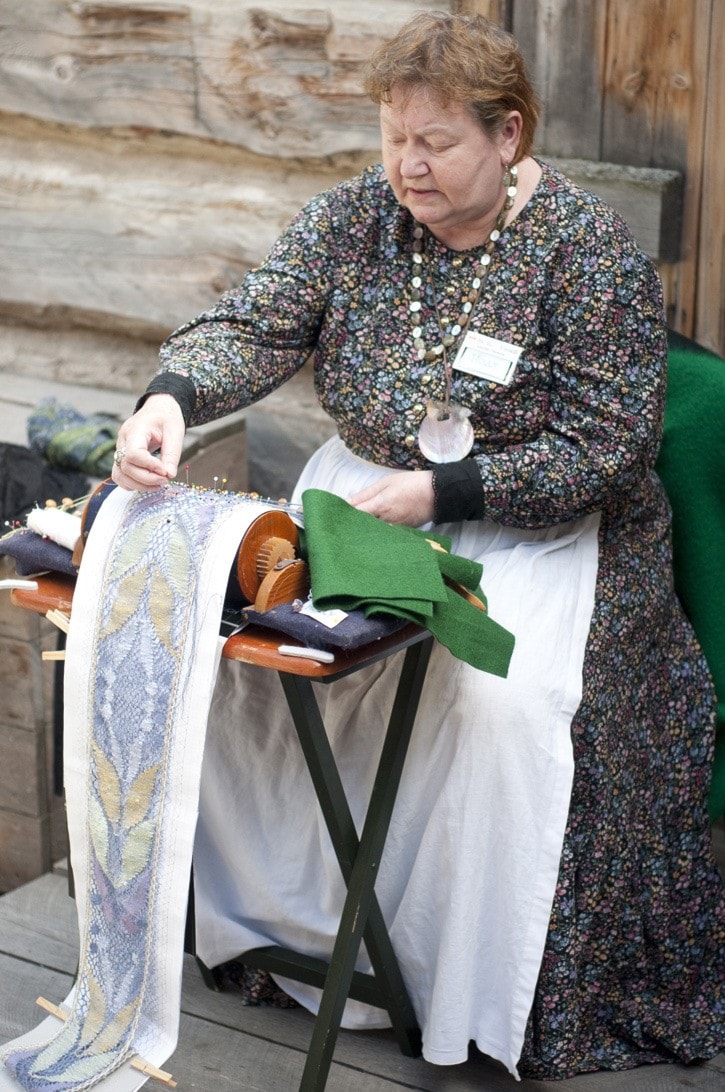If you ever wondered how they made lace, well now you can see how it was done, right here in Fort St. James.
While the majority of lace today is generally made by machines using standard patterns, lace was originally handmade using bobbins and thread, all by hand.
The woman demonstrating the traditional craft is Holly Behncke, a German retiree who has always dreamed of living in Canada.
“It’s not that it’s so complicated … it just needs a lot of patience,” explains Behncke.
She explains how the one piece she is showing me probably took her around 500 hours to do the 1.8 m in length scarf out of raw silk. But while time consuming, she said hand made lace is more unique and quite different from the machine-made lace made largely in Asia.
“If you make it by hand .. they have a kind of character,” she explains.
Using complicated cross and turn patterns, she sits in a chair at the Fort St. James National Historic Site for about five hours a day, volunteering to do her hobby in public so she can help to educate people about a nearly lost art.
But far from being bored after already volunteering for hundreds of hours, Behncke is extremely enthusiastic about what she is doing.
“I’ve met so many wonderful people, it’s just unreal,” she said.
Behncke enjoys showing people the ancient craft and said while many European travellers take it in stride, because it is known more widely in Europe, Canadian visitors to the historic park are amazed.
“The attention I get over here, it’s something I’m not familiar with,” she said, explaining how she loves to see the joy in people’s eyes as she demonstrates the art.
But it’s not only the people who keep Behncke going back to the park day after day to spend her time, it is also the location itself.
“To sit in this kind of spot doing this is just so special.”
She came to the community of Fort St. James with her daughter last September, and she instantly felt a connection to the place.
“We felt so comfortable in this little community,” she said. “I can hardly describe it.”
The historic site itself was somewhere she was interested in visiting, and when she first came to Fort St. James last year, she hadn’t made it to the park. But when she returned this last time to stay with her daughter, she knew she would like to see the park and she brought over some of her lace-making equipment with demonstrations in mind.
“This historic site is really special,” she said. “I feel (like) family with these people.”
Behncke is hoping to move to Canada permanently, which would be the fulfillment of a lifelong dream she has had, and one which was rekindled in a visit to Canada for a vacation 16 years ago.
Her daughter Xena, who works here in Fort St. James, remembers her parents enthusiastic descriptions of Canada after their return from that trip, and it is part of what inspired her to move to Canada to work.
For her part, Behncke is happy to be here, and happy to be sharing her skills, and her friends back in Germany can hardly believe what she gets to do here.
“I really feels blessed right now to find a place like this.”
Behncke is even planning on teaching others how to make lace in classes, but is working on getting the necessary supplies, as the equipment for the craft is hard to find in Canada.
Anyone who might have some old bobbins for making lace, linen thread or other supplies, or who is interested in learning lace-making can contact the Fort St. James National Historic Site.
She will be returning to Germany at the beginning of October, where she will be taking further courses in lace-making there to help develop her skills even further.
“It’s like you learn a language,” she said of her craft. “It’s a kind of passion, but then it’s a most wonderful thing to do.”
